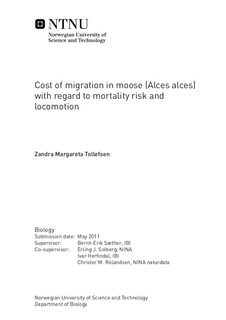Cost of migration in moose (Alces alces) with regard to mortality risk and locomotion
Master thesis
Permanent lenke
http://hdl.handle.net/11250/244826Utgivelsesdato
2011Metadata
Vis full innførselSamlinger
- Institutt for biologi [2566]
Sammendrag
Summary1. Migration is present in all animal taxa and is defined as a periodic movement pattern between given ranges. Migratory individuals generally move more directional and with higher speed than stationary individuals during the migration seasons. It is suggested that migratory individuals in these periods encounter more risk factors, and therefore experience a higher mortality.2. I studied the variation in the speed of movement and the number of times migratory and stationary moose were crossing elements associated with mortality risk, i.e. water bodies, roads and railroads, in Central Norway. This was done by examining the movement pattern of 121 GPS-collared moose. I also examined whether realized mortality differed between the two movement strategies. 3. The results only partly supported my hypothesis that migratory moose experience higher costs of movement and are confronted with more risk elements than stationary moose. As predicted, migratory moose moved faster than stationary moose, particularly during the migratory season. However, stationary moose had higher densities of risk elements within their home ranges, and crossed risk elements more frequently than migratory moose. For a given density of risk elements, migratory moose crossed more frequently, supporting the hypothesis that migratory moose are less risk adverse. This pattern was present throughout the year, suggesting that the behavior is not only related to higher movement during the migratory period. 4. I found no effect of movement strategy on the mortality rates, but the sample size was low. However, the trend of realized mortality was opposite of what I expected, with migratory moose having a lower mortality rate than stationary moose.5. My results suggest that migratory moose experience a higher risk of mortality by their movement strategy compared to stationary moose. However, this varies between individuals. By considering individual differences in costs of migration, it is possible to increase our understanding of partial migration. Increased human induced risks such as roads, will most likely increase the number of road crossings. The differences between the two movement strategies in number of crossings will most likely decrease as risk density increase, resulting in a high crossing frequency of risk factors performed by moose.
